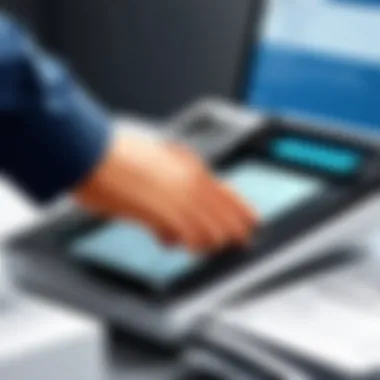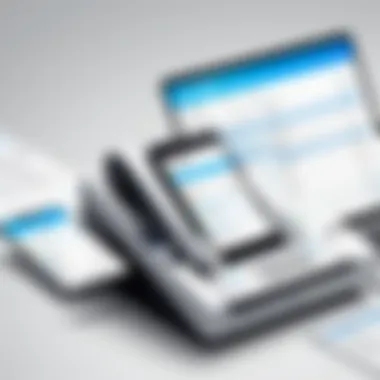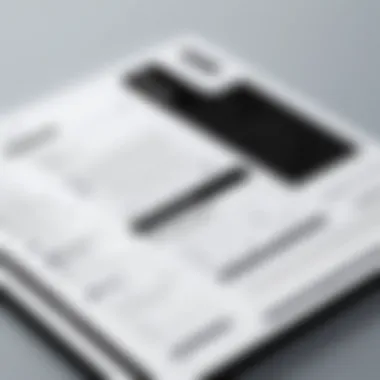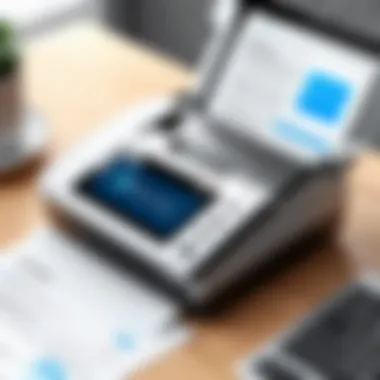Top E-Fax Providers: A Comprehensive Analysis


Intro
In a digital age where communication methods evolve rapidly, e-faxing remains a vital tool for many businesses. Traditional fax machines are gradually becoming obsolete due to the increasing use of electronic communication infrastructure. E-fax technology presents an alternative that merges traditional faxing capabilities with the conveniences of modern digital communication. This article discusses top e-fax providers, dissecting their features, pricing models, and distinctive advantages. Understanding these components is crucial for decision-makers looking to streamline operations and improve communication efficiency.
Using e-fax systems can enhance the way businesses engage with clients, vendors, and partners. Employing such a service can reduce paper waste, lower costs, and increase accessibility for teams. The landscape of available e-fax solutions is rich and varied. This analysis will assist businesses in navigating their options, guaranteeing they make eplicit choices that align with their specific needs.
Key Features
Overview of Features
The selection of e-fax services encompasses various functionalities. Not every provider operates on the same framework, or offers the identical suite of tools. Key features commonly found in leading e-fax solutions include:
- User Interface: An intuitive design ensures ease of use, allowing users to send and receive faxes without complications.
- Document Security: Security options such as encryption and password protection are crucial in safeguarding sensitive data.
- Integration Capabilities: The ability to seamlessly integrate with existing software solutions, like email and cloud storage systems, enhances productivity.
- Mobile Support: Mobile access empowers users to manage faxes from their smartphones or tablets, catering to a modern, mobile workforce.
These features can significantly influence a business's operational efficiency.
Unique Selling Propositions
Different e-fax providers differentiate themselves through unique selling propositions (USPs). For instance:
- eFax.com: Known for its easy-to-use web interface, eFax.com also provides unlimited incoming faxes, making it suitable for high-volume needs.
- MyFax: This provider offers strong customer support, with 24/7 assistance, appealing particularly to businesses needing consistent help.
- RingCentral Fax: An excellent choice for those already using RingCentral's communication tools, as it boasts smooth integration with their other services.
The USPs of these services play a vital role in assisting businesses to align their choices with specific operational preferences and requirements.
Pricing Models
Different Pricing Tiers
The e-fax market features diverse pricing models catering to various business needs. Common pricing structures include:
- Pay-Per-Fax: Ideal for businesses with infrequent faxing needs. Users only pay for each fax sent or received.
- Monthly Subscription Models: This structure offers fixed pricing for a set number of faxes, and potentially additional faxes at a lower rate.
- Enterprise Solutions: Larger organizations may require bespoke pricing based on their volumes and specific features.
Each pricing tier has pros and cons that can impact overall operational costs.
ROI and Cost-Benefit Analysis
When considering an e-fax solution, businesses must conduct a cost-benefit analysis. The return on investment can be significant with the right choice. Possible factors to assess include:
- Operating Costs: Analyzing the overall cost savings from reduced paper and maintenance for traditional fax machines.
- Efficiency Gains: Estimating time saved by audit trails and clear documentation compared to traditional methods.
- Scalability Options: Considering whether the selected e-fax solution can accommodate growth, preventing the need for future changes.
"A meticulous evaluation of both the tangible and intangible benefits will provide clarity in selecting the most effective e-fax provider.”
Adopting the right e-fax service can lead to long-lasting benefits. Understanding its features, pricing models, and associated costs can help guide businesses in making informed decisions.
Prologue to E-Fax Services
In a rapidly evolving digital world, the necessity for efficient document transmission remains pertinent. E-fax services have emerged as a modern solution to traditional faxing methods. It allows users to send and receive faxes electronically without the need for physical machines or paper. This shift not only aligns with growing environmental concerns but also enhances operational efficiency.
The significance of e-fax services lies in their ability to streamline communication processes for businesses. Organizations can improve productivity, reduce overhead costs, and ensure a more secure means of document transfer. With various providers available, understanding what e-fax can do for a business is crucial for decision-makers.
Understanding E-Fax Technology
E-fax technology converts traditional fax documents into digital formats. Incoming faxes are typically received in the form of email attachments while outgoing faxes can be sent directly from a computer. The process involves several technical steps. First, the document is scanned and digitized. Second, it's transmitted over the internet, often through a service provider's dedicated infrastructure. Finally, the receiving party retrieves the document through their designated method, usually email or web portal.
E-fax platforms may offer additional functionality, such as cloud storage integration, status tracking, and access from mobile devices. These features make it easier for users to manage their fax communications while ensuring they remain compliant with regulatory standards.
Advantages of E-Fax Over Traditional Fax
E-fax services present multiple advantages in comparison to traditional fax methods:
- Cost Efficiency: Minimal hardware at hand. No need for paper, toner, or a dedicated fax machine saves money.
- Accessibility: Documents can be sent and received from anywhere with internet access. This mobility is crucial for remote work.
- Ease of Use: E-fax solutions typically feature user-friendly interfaces. Sending and receiving a fax often takes just a few clicks.
- Security: E-fax services often come with encryption and secure transfer protocols, reducing the risk of interception.
- Environmentally Friendly: Reduction in paper usage aligns with eco-friendly goals.


"Businesses embracing e-fax technology can enhance their communication and reduce costs significantly."
Criteria for Evaluating E-Fax Providers
When businesses consider adopting e-fax solutions, it is crucial to evaluate the providers based on specific criteria. This ensures that the chosen service aligns with their operational needs, security demands, and budget constraints. Evaluating these factors not only aids in identifying the right provider but also helps in maximizing efficiency and productivity while minimizing costs.
User-Friendliness and Interface Design
A user-friendly interface is essential when selecting an e-fax provider. Complex systems can lead to confusion and frustration among users. A clean and intuitive design allows users to navigate the software without extensive training, which increases productivity. Providers like eFax and MyFax offer simple dashboards that simplify the fax process, enabling employees to send and receive documents effortlessly.
Moreover, mobile compatibility is important. Many users expect to access e-fax services from their smartphones or tablets. Therefore, checking if a provider offers an app or mobile-friendly site is advisable. Overall, the ease of use is a significant factor influencing user satisfaction and adoption rates within a business.
Security Features
Security should be a top priority when evaluating e-fax providers. Unlike traditional faxing, which transmits documents over phone lines, e-faxing sends data via the internet. This makes it vulnerable to cyber threats. Consequently, businesses must ensure that their provider uses strong encryption protocols. Look for certifications such as HIPAA compliance, especially for industries that handle sensitive information.
Additionally, two-factor authentication can bolster security. It prevents unauthorized access by requiring a second form of identity verification. Considering these features when evaluating a provider could mean the difference between safeguarding sensitive business information and experiencing a data breach.
Integration with Existing Systems
The ability of an e-fax solution to integrate smoothly with existing business systems is another critical consideration. Businesses often operate with various software tools, such as CRMs or document management systems. If an e-fax provider offers seamless integration, it can contribute to operational efficiency. For example, providers like RingCentral Fax allow users to send faxes directly from their email accounts or integrated apps, which streamlines workflows.
Additionally, Integration with cloud storage services like Google Drive or Dropbox can enhance functionality. Accessing and managing documents becomes easier when users can link multiple tools. Thus, it is wise to assess integration capabilities before making a final selection.
Pricing Models and Value for Money
Understanding pricing models allows businesses to find e-fax solutions that fit their budgets. Providers may offer various plans, including pay-per-use, subscription-based, or tiered pricing. Evaluating these options helps determine the long-term financial implications of choosing a particular provider.
It’s important to examine what features are included at each pricing tier. Some providers may charge additional fees for services such as support or extras like additional storage. Thus, making a thorough comparison can illuminate which plans offer the best value for money.
Moreover, reading customer reviews and testimonials can provide insights into whether the service meets its promises. This step is essential for validating the provider's reputation and reliability.
Overview of Top E-Fax Providers
In today’s digital world, choosing an e-fax provider can significantly influence a business's operational efficiency. E-fax services eliminate the need for traditional fax machines, allowing you to send and receive faxes via email or online platforms. This transition is essential as many organizations look for ways to reduce costs and streamline communication. E-fax providers offer diverse functionalities, catering to different needs, and it is imperative to understand the best options available.
E-fax providers differ in their features, pricing, and overall user experience. For instance, some may offer advanced security features, critical for industries like healthcare or financial services. Others might emphasize ease of use, appealing to businesses that prioritize operational simplicity. By evaluating these factors, businesses can choose a provider that aligns with their specific needs.
"Understanding the offerings of these providers is key to enhancing organizational communication."
However, selecting the right provider is not without challenges. Businesses often face a myriad of options, each promising unique benefits. Therefore, it is crucial to examine the various services offered and how they contribute to achieving effective communication goals. This section will outline several leading e-fax providers, showcasing their features, pricing, and the pros and cons associated with each.
Provider One
Key Features
Provider One stands out with its intuitive interface that simplifies the faxing process. Users can send documents directly from their email, which minimizes the hassle of using standalone devices. This directly contributes to increased productivity because users can manage their faxing tasks without needing to leave their primary work environment.
Another important aspect is the availability of mobile applications. This feature allows users to send and receive faxes on the go, adding convenience to busy professionals. However, the basic functionality may lack certain advanced options such as tracking and scheduling faxes.
Pricing
In terms of pricing, Provider One offers tiered subscription plans to accommodate a range of business sizes. This flexibility is a major advantage, making it a popular option for startups to larger enterprises. The frugal options allow users to pay only for the services they need. On the downside, some users have reported that the cost can add up if additional features are activated, making budgeting a bit tricky.
Pros and Cons
The main advantages of Provider One include ease of use and flexibility. Its user interface is often praised as being particularly accessible. However, some cons are evident too. Users have noted that customer support could be improved, especially during peak hours, leading to frustration at times when assistance is most needed.
Provider Two
Key Features


Provider Two offers robust security measures, crucial for organizations handling sensitive information. The dual-level encryption ensures that all documents remain confidential during transit. This security emphasis makes it a preferred choice for regulations-heavy industries.
Moreover, the platform includes seamless integration with cloud services like Google Drive and Dropbox. This integration simplifies document management, aligning well with modern business practices.
Pricing
When it comes to pricing, Provider Two takes a competitive stance in the e-fax market. They also provide a free trial period, which allows businesses to assess its features before fully committing financially. However, the subscription can be pricier compared to others available in the market. Businesses should weigh this cost against the significant security benefits offered.
Pros and Cons
The strengths of Provider Two lie in its comprehensive security protocols and effective integrations. Yet, its higher pricing might deter smaller businesses or those solely reliant on basic fax functionality, serving only to increase the decision complexity.
Provider Three
Key Features
Provider Three distinguishes itself with a powerful analytics dashboard that tracks fax usage and performance metrics. This feature helps businesses make informed decisions regarding their communication strategy. Additionally, it allows for unlimited cloud storage, ensuring easy access and retrieval of documents.
However, while these features enhance utility, the platform may have a steeper learning curve. Users who prefer straightforward functionalities might find this overwhelming initially.
Pricing
Provider Three operates on a subscription model that varies based on the level of service. Although many find its prices reasonable, there are no options for pay-as-you-go plans. This rigidity can be a drawback for companies that have fluctuating faxing needs.
Pros and Cons
The advantages are simplicity in tracking and extensive storage capacity. On the flip side, the lack of flexible pricing can alienate potential users who do not need continuous access to full services, thus limiting its user base.
Provider Four
Key Features
Provider Four excels in customer support, offering 24/7 assistance via multiple channels. This availability is crucial for businesses requiring immediate help with their faxing services. Additionally, they provide customizable templates which enhance user efficiency, particularly for regular document types.
The flexibility in template design streamlines processes for repeat documents, ensuring quicker turnaround times for common tasks.
Pricing
The pricing model is straightforward, with a monthly subscription that includes all features. This simplicity appeals to many users who prefer clear-cut billing. Nevertheless, businesses comparing costs may find it less economical than alternatives with modular pricing.
Pros and Cons
Notable strengths include exceptional customer service and tailored templates. However, businesses with infrequent fax needs may find the subscription model unjustifiable, leading to potential dissatisfaction.
Provider Five
Key Features
Provider Five is recognized for its wide range of customization options. This facility enables businesses to modify workflows extensively according to their specific preferences. Moreover, it provides an effective mobile platform that allows for faxes to be sent from various mobile devices.
However, the abundance of choices can be somewhat intimidating for new users. They may find it challenging to navigate through numerous functions to find what works best for them.
Pricing
Provider Five employs a subscription approach with multiple pricing tiers. The structure is beneficial for scaling operations; however, some users have expressed concerns about potential hidden fees. Transparency in what is included could enhance overall user satisfaction.
Pros and Cons
Customization options serve as a key strength, giving users precise control over their faxing capabilities. Contrarily, the complexity of features might alienate less tech-savvy individuals or small businesses primarily needing basic fax capabilities.
Comparative Analysis of E-Fax Providers


The comparative analysis of e-fax providers is crucial for businesses aiming to enhance their communication methods. As organizations become more digitized, understanding the differences among various e-fax services can significantly influence operational efficiency. It allows decision-makers to identify the strengths, weaknesses, and market positioning of each provider. Ultimately, this analysis helps businesses choose a provider that best fits their specific needs, whether for cost-effectiveness, security, or ease of use.
Strengths and Weaknesses
When comparing e-fax providers, it is important to evaluate their strengths and weaknesses. Some platforms may offer superior user interface design, enabling easier navigation and better user experience. For instance, providers like eFax and HelloFax are known for their intuitive layouts. This can make training employees less time-consuming and reduce errors in critical tasks.
On the contrary, some providers might have limitations in terms of functionality or integration capabilities. For example, an e-fax service that lacks API integration can hinder workflows that rely on other software tools. Understanding these strengths and weaknesses allows businesses to weigh what matters most to their operations.
- Pros of Strong Providers:
- Cons of Weaker Providers:
- User-friendly interfaces
- Comprehensive security features
- Competitive pricing strategies
- Limited features
- Poor customer support
- Higher operational costs
Market Positioning
The position in the market is another important element to analyze. This refers to how e-fax providers differentiate themselves and their offerings. Understanding market trends helps businesses align their needs with the provider's capabilities. For instance, certain providers may focus on specific industries such as healthcare or legal services, optimizing their offerings for compliance and regulatory needs.
This positioning impacts the choice for many businesses. A provider that specializes in legal documentation may be favored by law firms, while a more generalist provider would be better suited for companies across various sectors. Evaluating how each provider positions itself can help in making informed decisions. Factors to consider include:
- Specialization in industries
- Geographic service reach
- Brand reputation and customer base
User Experiences and Reviews
User experiences and reviews serve as a valuable resource in the comparative analysis of e-fax services. They provide insight into how real users interact with different platforms. Gathering feedback can indicate whether a provider meets customer expectations in terms of performance and reliability.
Various platforms such as Reddit and Facebook can provide user-generated insights. Clients often share their experiences with issues like service reliability and customer support responsiveness.
- Positive Experiences:
- Negative Experiences:
- Efficient customer service
- Consistent uptime
- Rapid document delivery
- Complicated setup processes
- Inadequate security measures
- Slow response times during peak hours
User reviews can reveal patterns that may not be immediately evident through marketing materials, making them a critical component in the evaluation process.
Future Trends in E-Fax Technology
Understanding future trends in e-fax technology is crucial for businesses aiming to streamline communication. As technology evolves, e-fax services are no longer confined to traditional methods. Innovations are reshaping how documents are sent and received, emphasizing efficiency and security. Companies need to stay abreast of these trends to harness their full potential and maintain a competitive edge.
Emerging Features and Innovations
The future of e-fax is characterized by several emerging features. Some notable innovations include:
- AI Integration: E-fax services are increasingly utilizing artificial intelligence to automate processes such as document indexing and sorting. This reduces manual errors and improves efficiency.
- Mobile Capabilities: The demand for mobile access is on the rise. Users can send and receive faxes from smartphones and tablets, enabling on-the-go transactions.
- Advanced Security Measures: With cybersecurity becoming a top priority, e-fax providers are implementing enhanced security features. These may include end-to-end encryption and two-factor authentication.
- User Customization: Customizable interfaces and features allow users to tailor their e-fax experience according to their business needs.
Such innovations not only improve user experience but also address compliance requirements essential in fields such as healthcare and finance. Businesses should evaluate how these features can integrate into their existing workflows for maximum benefit.
The Role of Cloud Services
Cloud services are revolutionizing the way e-fax operates. By leveraging cloud technology, e-fax systems provide numerous benefits:
- Scalability: Businesses can adjust their e-fax services according to changing needs without significant upfront investment.
- Accessibility: Employees can access faxes from anywhere, provided they have internet connectivity. This flexibility supports remote work and collaboration.
- Cost Efficiency: Utilizing cloud services can lead to decreased operational costs. Subscription models often replace hefty hardware costs associated with traditional fax machines.
- Integration with Other Services: Cloud-based e-fax solutions can easily integrate with existing systems like CRM and ERP software.
"The integration of cloud services in e-fax solutions indeed simplifies operations while enhancing flexibility and security."
Evaluating how these trends impact operational efficiency can guide decision-making for businesses that rely on fax communication. Understanding these advancements is vital for fostering innovation and optimizing communication strategies.
Closure
In the realm of modern business communication, the role of e-fax services cannot be understated. The shift from traditional faxing methods to digital solutions offers not just efficiency but also enhances security and integration capabilities. This article aims to substantiate the significance of choosing an appropriate e-fax provider, tailored to the specific needs of businesses.
Final Recommendations for Businesses
When selecting an e-fax provider, several critical factors should be considered:
- Assess Workflow Needs: Understand your business's unique requirements. Identify whether you need high-volume faxing or occasional use.
- Evaluate Security Features: Choose a provider that prioritizes data protection. Encryption and compliance with standards like HIPAA are vital for sensitive information.
- Test User Experience: Look for providers offering a user-friendly interface. A simple setup can significantly enhance operational efficiency.
- Integration with Existing Tools: Opt for e-fax services that support connection with other software already in use, such as CRM systems and email clients.
- Review Pricing Models: Understand the pricing structure thoroughly. Monthly subscriptions can vary significantly, so finding good value is key.
- Consider Customer Support: Reliable customer service can save time and headaches. Check reviews to gauge the provider’s reputation for support before making a commitment.
By focusing on these elements, businesses can make informed choices that align with their operational needs. Ultimately, selecting the right e-fax provider can lead to improved efficiency, enhanced communication, and significant cost savings.















